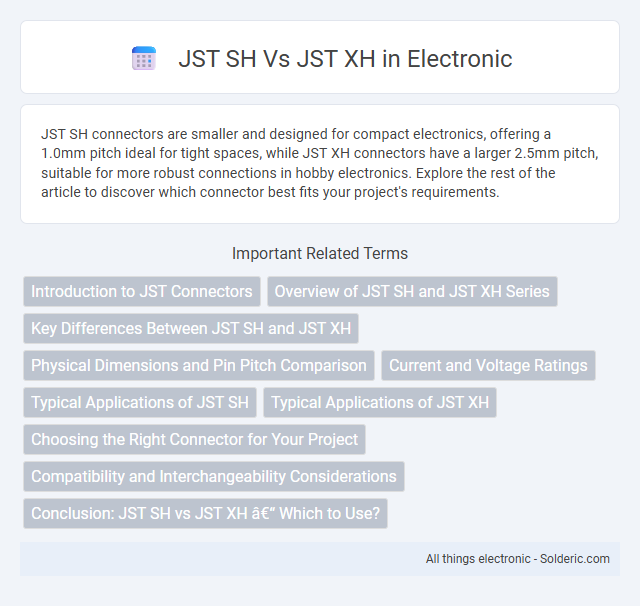JST SH connectors are smaller and designed for compact electronics, offering a 1.0mm pitch ideal for tight spaces, while JST XH connectors have a larger 2.5mm pitch, suitable for more robust connections in hobby electronics. Explore the rest of the article to discover which connector best fits your project's requirements.
Comparison Table
| Feature | JST SH | JST XH |
|---|---|---|
| Pitch (mm) | 1.0 | 2.5 |
| Current Rating | 3A | 3A |
| Contact Type | Pin and Socket | Pin and Socket |
| Wire Size Range | 28-22 AWG | 28-22 AWG |
| Connector Height | 7.9mm | 9.25mm |
| Typical Applications | Compact electronics, small devices | General electronics, PCB connections |
| Mounting Style | Wire-to-board | Wire-to-board |
Introduction to JST Connectors
JST connectors, including the SH and XH series, are widely used in electronic applications for their reliability and compact design. The JST SH series features a 1.0mm pitch, making it ideal for small-scale devices, while the JST XH series has a larger 2.5mm pitch suited for higher current connections. Understanding these differences helps you select the appropriate connector for your specific circuit requirements, ensuring secure and efficient connectivity.
Overview of JST SH and JST XH Series
JST SH and JST XH are popular series of connectors used in electronics for board-to-wire and wire-to-wire applications. The JST SH series features a 1.0mm pitch, making it ideal for compact, high-density designs requiring secure, low-profile connections. The JST XH series offers a larger 2.5mm pitch, providing robust, reliable connections suited for power distribution and signal transmission in medium to high current applications.
Key Differences Between JST SH and JST XH
JST SH connectors offer a 1.0mm pitch, while JST XH connectors provide a larger 2.5mm pitch, affecting their size and current capacity. The SH series is ideal for compact electronics with limited space, whereas XH connectors suit applications requiring higher current handling and sturdier connections. Understanding these key differences helps you select the appropriate connector for your project's spacing and electrical requirements.
Physical Dimensions and Pin Pitch Comparison
JST SH connectors feature a compact design with a 1.0 mm pin pitch, ideal for space-constrained applications, whereas JST XH connectors have a larger 2.5 mm pin pitch suitable for higher current requirements. The physical dimensions of JST SH connectors are generally smaller, with narrower housing width and reduced height compared to JST XH connectors, making them better for miniaturized electronic devices. The choice between JST SH and XH depends on balancing space limitations against current carrying capacity and mechanical robustness.
Current and Voltage Ratings
JST SH connectors typically support current ratings up to 1.0A per contact with a voltage rating around 50V, making them suitable for low-power applications. In contrast, JST XH connectors handle higher currents, usually up to 3.0A per contact and voltages up to 250V, offering greater flexibility for more demanding electrical loads. Your choice between JST SH and XH should consider these differences to ensure safe and efficient performance in your electronics project.
Typical Applications of JST SH
JST SH connectors are commonly used in compact electronic devices requiring reliable, low-current connections, such as drones, sensors, and small battery packs. Their small pitch design, typically 1.0mm, makes them ideal for space-constrained applications where JST XH connectors, with a larger 2.5mm pitch, would be too bulky. You benefit from JST SH connectors' precision and durability in miniaturized circuits needing secure connections under limited space.
Typical Applications of JST XH
JST XH connectors are commonly used in consumer electronics, lighting systems, and battery packs due to their reliable connection and compact size. These connectors support wire gauges from 26 to 22 AWG, making them ideal for medium-current applications up to 3A. Compared to JST SH connectors, which are typically found in smaller, low-current devices like drones and small PCBs, JST XH connectors provide more robust durability and are better suited for industrial and automotive wiring harnesses.
Choosing the Right Connector for Your Project
Selecting between JST SH and JST XH connectors depends on the project's space constraints and current requirements. JST SH connectors are compact with a 1.0mm pitch, ideal for high-density circuit boards and low-current applications up to 3A, while JST XH connectors have a larger 2.5mm pitch supporting higher currents up to 3A and better mechanical stability. For compact devices like wearable electronics, JST SH is preferred, whereas JST XH suits projects needing robust connections and easier handling.
Compatibility and Interchangeability Considerations
JST SH connectors feature a 1.0mm pitch, while JST XH connectors have a 2.5mm pitch, making them physically incompatible without adapters. The smaller pitch of JST SH limits current capacity compared to the higher-rated JST XH, impacting suitability for different electrical requirements. Interchanging these connectors without proper adaptation risks poor contact and potential damage to connecting devices.
Conclusion: JST SH vs JST XH – Which to Use?
JST SH connectors offer a smaller 1.0mm pitch suited for compact electronics with tight space constraints, while JST XH connectors feature a 2.5mm pitch ideal for applications requiring higher current capacity and easier handling. Your choice depends on the device's size, current requirements, and assembly convenience; SH fits microelectronics and delicate circuit boards, whereas XH is preferred for general-purpose wiring and power connections. Selecting between JST SH and JST XH ensures optimal performance by matching connector specifications to your project's electrical and spatial needs.
JST SH vs JST XH Infographic

 solderic.com
solderic.com